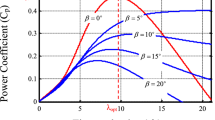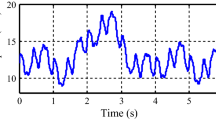Abstract
To improve power production and reduce loads on turbine components, exact wind speed information is required in modern wind turbine controllers. However, the wind speed measured on the nacelle is imprecise because of its drawbacks of single point measurement and non-immunity to disturbances. To solve this problem, the EWS (Effective Wind Speed) estimator has been proposed as an alternative. According to the literatures, there are two kinds of EWS estimator, that is, the KF-based estimator and the EKF-based one. Where, the former is applied to estimate the aerodynamic torque, then the EWS is numerically calculated; and the latter directly estimate the EWS. Since the estimate EWS significantly affect the controller’s effectiveness, their performance needs to be clarified. To fully investigate the two estimators, there is a need to evaluate their performance on an even platform. In this paper, we present comparative studies on these two methods. Their advantages and drawbacks are investigated on the commercial turbine design software-bladed and compared through detailed simulation results. Finally, we demonstrate some simulation results and differences between the KF-based estimator and the EKF-based one.
Similar content being viewed by others
References
H. Camblong, S. Nourdine, I. Vechiu, and G. Tapia, “Comparison of an island wind turbine collective and individual pitch LQG controllers designed to alleviate fatigue loads,” IET Renewable Power Generation, vol. 6, no. 4, pp. 267–275, April 2012.
B. Boukhezzar and H. Siguerdidjane, “Nonlinear control with wind estimation of a DFIG variable speed wind turbine for power capture optimization,” Energy Convers Manage, vol. 50, pp. 885–892, March 2009. [click]
H. C. Sung, B. P. Jin, and Y. H. Joo, “Robust observerbased fuzzy control for variable speed wind power system: LMI approach,” International Journal of Control, Automation & Systems, vol. 9, no. 6, pp. 1103–1110, December 2011. [click]
Z. Wei, B. Y. Moon, and Y. H. Joo, “Smooth wind power fluctuation based on battery energy storage system for wind farm,” Journal of Electrical Engineering & Technology, vol. 9, no. 6, pp. 2134–2141, December 2014.
H. C. Sung, M. H. Tak, and Y. H. Joo, “Robust fuzzy controller for mitigating the fluctuation of wind power generator in wind farm,” Journal of Institute of Control, Robotics and Systems (in Korean), vol. 19, no. 1, pp. 34–39, February 2013. [click]
D. Lee, H. C. Sung, and Y. H. Joo, “Fuzzy modeling and robust stability analysis of wind farm based on prediction model for wind speed,” Journal of Institute of Control, Robotics and Systems (in Korean), vol. 20, no. 1, pp. 22–28, February 2014.
J. K. Kim, and Y. H. Joo, “Fuzzy modeling and stability analysis of wind power system with doubly-fed induction generator,” Nurse Practitioner, vol. 22, no. 1, pp. 56–61, February 2012.
J. Yang, D. R. Song, and H. Han, “The integrated control of fuzzy logic and model-based approach for variable-speed wind turbine,” Turkish Journal of Electrical Engineering and Computer Sciences, vol. 23, no. 6, pp. 1715–1734, November 2015.
Z. Q. Wu, Y. Yang, and C. H. Xu, “Adaptive fault diagnosis and active tolerant control for wind energy conversion system,” International Journal of Control, Automation and Systems, vol. 21, no. 1, pp. 120–125, February 2015. [click]
M. N. Soltani, T. Knudsen, M. Svenstrup, R. Wisniewski, P. Brath, R. Ortega, and K. Johnson, “Estimation of rotor effective wind speed: a comparison,” IEEE Trans Control Syst, vol. 21, no. 4, pp. 1155–1167, July 2013. [click]
E. L. Van der Hooft and T. Engelen, “Estimated wind speed feed forward control for wind turbine operation optimisation,” Proc. Eur. Wind Energy Conf, pp. 1–9, November 2014.
N. Y. Kim, J. I. Paek, Y. H. Moon, S. J. Kim, and D. J. Kim, “Feedforward pitch control using wind speed estimation,” J Power Electron, vol. 11, no. 2, pp. 211–217, March 2011. [click]
H. L. Henriksen, “Nonlinear model predictive control of a simplified wind turbine,” World Congress, pp. 551–556, September 2011.
G. Sohei and M. Ali, “Variable speed wind turbines with maximum power extraction using singular perturbation theory,” Energy, vol. 106, pp. 510–519, April 2016. [click]
S. M. Tabatabaeipour, P. F. Odgaard, T. Bak, and J. Stoustrup, “Fault detection of wind turbines with uncertain parameters: a set-membership approach,” Energies, vol. 5, pp. 2424–2448, May 2012. [click]
P. Sørensen, A. D. Hansen, and P. A. Rosas, “Wind models for simulation of power fluctuations from wind farms,” Journal of Wind Engineering & Industrial Aerodynamics, vol. 90, no. 12, pp. 1381–1402, December 2002. [click]
K. Z. Østergaard, P. Brath, and J. Stoustrup, “Estimation of effective wind speed,” J Phys Conf Ser, vol. 75, pp. 1–9, 2007.
T. Knudsen, M. Soltani, and T. Bak, “Prediction models for wind speed at turbine locations in a wind farm,” Wind Energy, vol. 14, no. 7, pp. 877–894, August 2012.
C. D. Zuluaga, M. A. Álvarez, and E. Giraldo, “Short-term wind speed prediction based on robust Kalman filtering: an experimental comparison,” Appl Energy, vol. 156, pp. 321–330, September 2015. [click]
A. Gelb, J. F. Kasper, R. A. Nash, and C. F. Price, Sutherland AA. Applied Optimal Estimation, The M. I.T. Press, London, England, 1974.
M. S. Grewal and A. P. Andrews, Kalman Filtering: Theory and Practice Using MATLAB, 2nd ed., Wiley, New York, NY, USA, 2001.
GH bladed User Manual, Garrad Hassan and Partners Ltd, 2009.
IEC 61400-1 International Standard, Wind Turbines–Part 1: Design Requirements, 2nd ed, International Electrotechnical Commission, Geneva, Switzerland: IEC, 2005.
W. H. Press, S. S. Teukolsky, W. T. Vetterling, and B. P. Flannery, Numerical Recipes in C, Cambridge University Press, Cambridge, England, 1992.
Author information
Authors and Affiliations
Corresponding authors
Additional information
Recommended by Associate Editor Do Wan Kim under the direction of Editor Duk-Sun Shim. This work is supported by the National Natural Science Foundation of China under Grant 51677194, the National High-tech R&D Program of China (863 Program) under Grant 2015AA050604, the Project of Innovation-driven Plan in Central South University, the Program for New Century Excellent Talents in University under Grant NCET-13-0599, the Fundamental Research Funds for the Central Universities of Central South University under Grant 2015zzts050, and the Basic Science Research Program through the National Research Foundation of Korea (NRF) funded by the Ministry of Education (NRF-2016R1A6A1A03013567).
Dong-Ran Song received the B.S. and M.S. degrees in Automation from the School of Information Science and Engineering, Central South University, Changsha, China, in 2006 and 2009, respectively, where he is currently working toward the Ph.D. degree. He was an Electrical & Control Engineer with China Ming YangWind Power, Zhongshan, from 2009 to 2013. His current research interests include advance control algorithms for wind turbines, power electronics and renewable energy generation system.
Jian Yang received the Ph.D. degree in Electrical Engineering from the University of Central Florida, Orlando, in 2008. He was a Senior Electrical Engineer with Delta Tau Data Systems, Inc., Los Angeles, CA, from 2007 to 2010. Since 2011, he has been with Central South University, Changsha, China, where he is currently an Associate Chair Professor with the School of Information Science and Engineering. His main research interests include control application, motion planning, and power electronics.
Mi Dong received the Ph.D. degree in Control Theory and Control Engineering from the School of Information Science and Engineering, Central South University, Changsha, China, in 2007. Since 1999, she has been with Central South University, Changsha, China, where she is currently an Associate Professor with the School of Information Science and Engineering. Her main research interests include control application, solar photovoltaic power generation system and power grid power quality.
Young Hoon Joo received the B.S., M.S., and Ph.D. degrees in Electrical Engineering from Yonsei University, Seoul, Korea, in 1982, 1984, and 1995, respectively. He worked with Samsung Electronics Company, Seoul, Korea, from 1986 to 1995, as a project manager. He was with the University of Houston, Houston, TX, from 1998 to 1999, as a visiting professor in the Department of Electrical and Computer Engineering. He is currently a professor in the Department of Control and Robotics Engineering, Kunsan National University, Korea. His major interest is mainly in the field of intelligent control, intelligent robot, human-robot interaction, wind-farm control, power system stabilization, and intelligent surveillance systems. He seversed as President for Korea Institute of Intelligent Systems (KIIS) (2008-2009) and is serving as the Editor-in-Chief for the International Journal of Control, Automation, and Systems (IJCAS) (2014-present) and the Vice-President for the Korean Institute of Electrical Engineers (KIEE) (2013-present) and for Institute of Control, Automation, and Systems (ICROS) (2016-present). Also, he is serving as Director of Research Center of Wind Energy Systems funded by Korean Government (2016-present).
Rights and permissions
About this article
Cite this article
Song, D., Yang, J., Dong, M. et al. Kalman filter-based wind speed estimation for wind turbine control. Int. J. Control Autom. Syst. 15, 1089–1096 (2017). https://doi.org/10.1007/s12555-016-0537-1
Received:
Revised:
Accepted:
Published:
Issue Date:
DOI: https://doi.org/10.1007/s12555-016-0537-1




